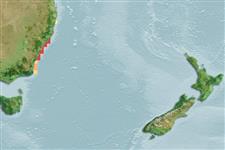klasifikasi / Names
Nama-nama umum | Sinonim (persamaan) | Catalog of Fishes(Marga, Jenis) | ITIS | CoL | WoRMS | Cloffa
>
Pleuronectiformes (Flatfishes) >
Soleidae (Soles)
Etymology: Aseraggodes: Greek, aggos, -eos, -ous = vessel, uterus, carapace of a crab + Greek, aseros, -a, -on = to remove the appetite (Ref. 45335); lenisquamis: Name from the Latin words 'lenis' for soft or smooth and 'squamma' fro scale, referring to the distinctive scale structure; cteni nearly covered by soft epidermal tissue, only the tips exposed at the scale margin..
More on author: Randall.
Environment: milieu / climate zone / depth range / distribution range
Ekologi
laut; payau dasar (demersal); kisaran kedalaman 4 - 10 m (Ref. 57560). Subtropical
Southwestern Pacific: New South Wales, Australia.
Size / Weight / umur
Maturity: Lm ? range ? - ? cm
Max length : 10.2 cm SL jantan/; (Ref. 57560)
deskripsi pendek
Morfologi | Morfometrik
duri punggung lunak (Keseluruhan (total)): 62-70; Sirip dubur lunak: 46 - 52; vertebrata, bertulang belakang: 36 - 38. Diagnosis: Dorsal rays 62-70; anal rays 46-52; dorsal and anal rays branched. Lateral-line scales 62-68. including 8-9 anterior to a vertical at upper end of gill opening. Vertebrae 36-38; dorsal pterygiophores anterior to fourth neural spine 8-9. Body depth 2.4-2.65 in SL; head short, its length (HL) 4.75-5.05 in SL; eye diameter 4.6-5.7 in HL; upper eye overlapping about anterior one-third to one-half of lower eye; interorbital space variable in width; vertical distance separating eyes 7.3-13.7 in HL. Caudal peduncle absent. Lappet-like cirri on ventral edge of head, but not on front of snout; numerous cirri on opercular edge of gill opening on both sides; dense cirri over much of ventral part of head; exposed surface of scales overlaid with soft tissue; only tips of cirri visible at scale margins, capped with soft tissue; lateral-line scales with fleshy cirri, often one above and one below pore (cirri better developed on ocular than blind side); scattered other scales with a slender fleshy cirrus, often one from each corner of scale; membranous ridges of both sides of dorsal and anal rays with a conspicuous fringe of cirri. Some of which are bifid. Lateral line aligned with upper eye. Longest dorsal ray 1.65-1.8 in HL. Caudal fin rounded, its length 4.6-5.05 in SL; pelvic fins short, 1.8-2.2 in HL, the tip of longest ray reaching base of second anal ray. Ocular side light brown, with scattered small dark brown blotches; rays of fins with small dark brown spots (Ref. 57560).
Collected from sand in bays (Ref. 57560).
Life cycle and mating behavior
Kematangan | Reproduksi, perkembang biakan | Pemijahan | telur-telur | Fecundity | Larva
Randall, J.E., 2005. A review of soles of the genus Aseraggodes from the South Pacific, with descriptions of seven new species and a diagnosis of Synclidopus. Memoirs of Museum Victoria 62(2):191-212. (Ref. 57560)
Status IUCN Red List (Ref. 130435)
ancaman kepada manusia
Harmless
penggunaan manusia
informasi lanjut
Nama-nama umumSinonim (persamaan)metabolismePemangsaEkotoksikologiReproduksi, perkembang biakanKematanganPemijahanSpawning aggregationFecunditytelur-telurpekembangan telor
Umur / SaizPertumbuhanpanjang-beratpanjang-panjangukuran frekuensiMorfometrikMorfologiLarvaDinamika larvapemulihanKelimpahanBRUVS
AcuanBudidaya airprofil budidaya airStrainGenetikaElectrophoresesDiturunkanPenyakit-penyakitPengolahanNutrientsMass conversion
mitraGambarStamps, Coins Misc.Suara-suaraCiguateraKecepatanTipe renangArea insangOtolithsOtakPenglihatan / visi
Alat, peralatan
laporan khas
muat turun XML
Sumber internet
Estimates based on models
Preferred temperature (Ref.
123201): 17.8 - 23.3, mean 18.8 °C (based on 40 cells).
Phylogenetic diversity index (Ref.
82804): PD
50 = 0.5000 [Uniqueness, from 0.5 = low to 2.0 = high].
Bayesian length-weight: a=0.00977 (0.00473 - 0.02021), b=3.07 (2.90 - 3.24), in cm total length, based on LWR estimates for this (Sub)family-body shape (Ref.
93245).
Trophic level (Ref.
69278): 3.6 ±0.5 se; based on size and trophs of closest relatives
Daya lenting (Ref.
120179): Tinggi, Waktu penggandaan populasi minimum kurang dari 15 bulan (Preliminary K or Fecundity.).
Fishing Vulnerability (Ref.
59153): Low vulnerability (10 of 100).
